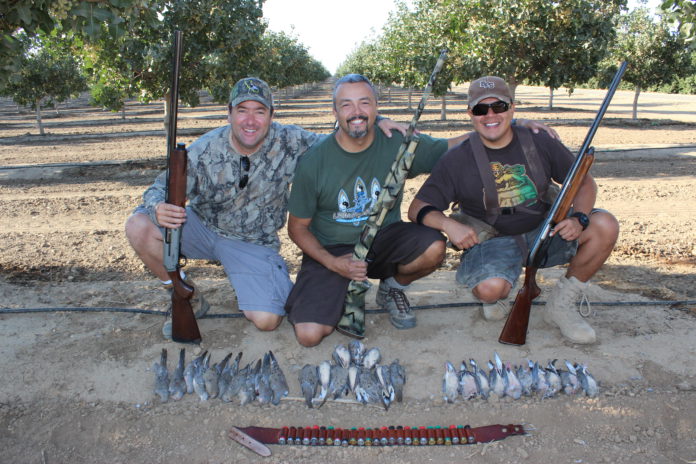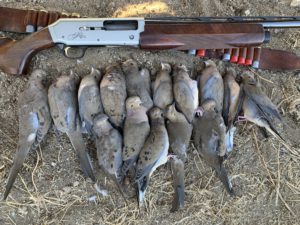
BY TIM E. HOVEY
About the middle of July, I start to notice the mourning dove flying through my neighborhood. If I’m out and about in the field, I start to make notes on dove flight patterns and I try to visit our regular hunting spots a few weeks before the season starts. Despite the summer heat, I can tell that the next hunting season is just around the corner.
For the last 20 yeas or so, I’ve found myself standing at the edge of good mourning dove habitat as the sunrises on the September 1 dove opener. I’m usually surrounded by good friends and am anxiously looking skyward as the birds start to fly. Whether you’re new to hunting or a veteran of dozens of openers, this feeling will never change – it’s time to hunt.
For me and my hunting clan, the mourning dove opener on September 1 signals the beginning of the hunting season. Calls and texts are traded prior to the opener and plans on location and who’s coming are firmed up. It’s been mentioned before in our group that we enjoy the planning and preparation as much as the hunt.
With over two decades of experience, we have a handful of spots that we routinely visit a time or two before the opener. We dust off the decoys and oil up the shotguns. More ammo than will ever be needed is boxed up and set next to all the gear. Like kids at Christmas, grown men will lose sleep waiting for that early morning drive to hunt dove.

Our regular spots are the result of scouting in the areas where all the right habitat requirements are met for mourning dove. First and foremost is a consistent water source. Reviewing google earth and just plain old boots on the ground, we’ve been able to find a few locations that hold water annually. Migratory birds like dove need to water several times a day and a close, consistent source of water will hold birds close by.
In my opinion, the next resource needed to draw and hold mourning dove is food. Adults eat a variety of plant and grass seeds. There really is no specialized seed they prefer and will consume the seeds of almost anything green. The seeds of wild grasses, non-native grasses and native perennials will all attract dove as a food source.
Lastly, and of equal importance to food and water is roosting trees. A roosting tree is someplace the birds can rest during the day as well as throughout the night. While they will roost in dead trees if their options are limited, they really prefer live trees with available leaves and foliage. Live trees provide the cover and security mourning dove prefer to rest during the evening.
If you’re California hunter, you should realize that all three of these essential habitat requirements are in abundance in and around just about any orchard in the state. Some of our best mourning dove hunting locations are at the edges of orchards, between dove food and water sources.
Believe it or not, the easy part of hunting mourning dove is finding them. One of the fastest birds out there, achieving speeds of near 55 MPH, a passing shot on a flying dove is challenging for even seasoned hunters. While I love taking new hunters out on an opening day mourning dove hunt, given the birds blistering speed, a part of me thinks it’s just about the cruelest thing you can do to someone that has never hunted before. However, over the years, we’ve come up with a solution to slowing these birds down.
Over the last decade or so we’ve been using the Mojo brand of fluttering dove called the Mojo Voodoo dove spinner. These decoys mimic the wing fluttering of landing dove and will definitely draw birds close. When employed with static decoys, this set up will bring mourning dove in and substantially slow them down as they prepare to land. If we’re hunting with new or less experienced hunters, we set them up near the decoys, giving them opportunities at slower birds approaching the set-up.
Like most game birds, dove have great eyesight and will easily spot you moving or avoid you altogether if you’re standing out in the open. Waiting in the shadows and camo clothing is a must if you want a chance at harvesting a good number of birds. Any clothing that breaks up you’re outline will get the job done.
As far as firearms, any shotgun you have in the safe will do. Pairing that with shells in the 7½ to 8 size are perfect for harvesting these small, delicate game birds. And do yourself a favor, bring extra shells. Even experience hunters may a take a box or two to get back into the swing of hitting these flying speedsters.
As most hunters know, California is now a lead-free state and only steel shot or non-lead shells may be used when pursing any game animal. The limit was raised from 10 to 15 birds per day a few years ago, giving hunters even more incentive to get out for a fall shoot.
It’s estimated that there are currently between 300 and 400 million mourning dove in the America’s and that hunters harvest close to 20 million birds annually. This indicates that dove hunting is the most popular hunting activity out there. And while these harvest numbers indicate that quite a few birds are added to game bags every year, in my opinion, a mourning dove hunt is more a social even than anything else.
The opener is a chance for new and old hunters to meet, to re-connect with good friends and to enjoy an event that has been ingrained in our hunting heritage for decades. If you’re a veteran of many dove openers, add to your clan this season and invite a new hunter along. A mourning dove hunt is a great way of introducing new hunters to the fold and that’s always a good thing. Just remember, if you think you’ve brought enough shells, add two more boxes.



